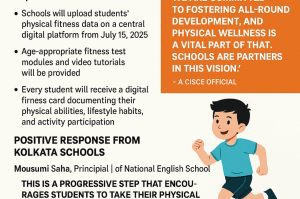CISCE Asks Schools to Track Students Fitness — In a pioneering move aligned with the vision of holistic student development, the Council for the Indian School Certificate Examinations (CISCE) has directed all its affiliated schools to begin assessing and tracking the physical fitness of students from Class I to XII. The initiative, welcomed by schools in Kolkata, is part of a broader effort to promote active and healthy lifestyles among schoolchildren across India.

‘Active CISCE’: Integrating Health with Education
The newly launched initiative, titled ‘Active CISCE’, is designed to make health and fitness a central part of a student’s educational journey. As per the council’s directive:
- Schools will be required to upload students’ physical fitness data on a central digital platform from July 15, 2025.
- Age-appropriate fitness test modules will be provided through the portal, along with detailed video tutorials to assist teachers and students.
- Every student will receive a digital fitness card, documenting their physical abilities, performance, lifestyle habits (diet, sleep, screen time), and participation in sports or physical activities.
The council has also stated that submission of this data will be mandatory for students of Classes IX and XI before they are allowed to register for their board exams.
“We are committed to fostering all-round development, and physical wellness is a vital part of that. Schools are partners in this vision,” a CISCE official stated.
Positive Response from Kolkata Schools
Educators across Kolkata have lauded the move as a step in the right direction. School heads say this policy not only brings much-needed attention to children’s physical well-being but also formalizes a structured way to track and promote fitness from an early age.
Mousumi Saha, Principal of National English School, noted:
“This is a progressive step that encourages students to take their physical health seriously. It’s a welcome change.”
Rodney Borneo, Principal of St. Augustine’s Day School, Shyamnagar, echoed the sentiment:
“In today’s world, schools must play an active role in monitoring student health. Having such records is useful not just academically, but also during emergencies or health evaluations.”
How the Fitness Programme Works
The programme includes several components tailored to student age groups:
- Fitness Tests: Basic evaluations like push-ups, sit-ups, sprints, flexibility tests, balance exercises, and endurance runs will be used to assess students.
- Lifestyle Monitoring: Students’ daily habits such as sleep duration, diet choices, hydration levels, and screen time will be self-recorded and reviewed periodically.
- Progress Reports: Teachers and physical education instructors will guide students to improve upon their scores, and parents will have access to view their child’s progress online.
The platform is expected to be both interactive and intuitive, ensuring ease of access for schools of various sizes and resource levels.
A Push for National Education Policy Alignment
The CISCE’s move aligns with the National Education Policy (NEP) 2020, which emphasizes the integration of physical education and mental wellness into mainstream academics. The NEP envisions an education system that not only imparts cognitive knowledge but also fosters emotional, physical, and social intelligence.
This fitness tracking system is likely to become a model for other education boards, especially with increasing awareness about rising obesity and inactivity levels among Indian schoolchildren.
Why Fitness Monitoring Matters
Several studies over the past decade have shown a significant rise in sedentary behavior among children, largely due to increased screen time, exam pressure, and reduced outdoor play. Health experts warn that this leads to:
- Poor cardiovascular fitness
- Weak core strength and flexibility
- Increased cases of childhood obesity
- Lifestyle-related conditions like early-onset diabetes and hypertension
A structured monitoring mechanism will help identify red flags early, allowing schools and parents to take corrective action. It also helps promote sports culture, encourages participation in co-curricular physical activities, and boosts mental alertness and academic performance.
Challenges and Expectations
While most schools welcome the move, implementing the system will come with some logistical challenges:
- Training of Staff: Teachers, especially in smaller schools, may require orientation on how to conduct physical assessments and input data into the portal.
- Parental Involvement: The success of the lifestyle-tracking component depends on honest inputs from both students and their families.
- Infrastructure Constraints: Schools without sufficient sports facilities or trained physical education staff may need additional support.
However, CISCE has indicated that it will provide comprehensive guidelines, resources, and helplines to assist schools during the initial rollout.
Broader Impact and Long-Term Vision
By institutionalizing student fitness tracking, CISCE aims to:
- Promote active learning environments
- Encourage lifelong fitness habits
- Inculcate responsibility towards one’s health
- Spot athletic talent at an early stage
Moreover, the fitness cards could potentially serve as reference documents for college admissions, sports scholarships, and medical consultations.
Digital Integration: Key to the Programme’s Success
The portal where schools will upload data is expected to:
- Auto-generate fitness progress graphs
- Highlight students who need additional support
- Showcase high-performing students in various categories
- Store year-wise data to track long-term improvements
With this data, school administrators and health coordinators can make evidence-based decisions, and policy-makers can gauge trends across regions.
External Links for Reference:
- CISCE Official Website: https://cisce.org
- Original Times of India article: https://timesofindia.indiatimes.com/city/kolkata/cisce-tells-schools-to-assess-students-fitness-parameters-kolkata-teachers-welcome-move/articleshow/122167581.cms
- National Education Policy 2020 (Full Document): https://www.education.gov.in/sites/upload_files/mhrd/files/NEP_Final_English_0.pdf
- Fit India Movement – Government Portal: https://fitindia.gov.in
CISCE Asks Schools to Track Students Fitness: Conclusion
With the “Active CISCE” programme, the Council has taken a bold and timely step to shift the conversation around student development beyond marks and exams. By placing fitness and lifestyle habits at the heart of school life, CISCE is setting the stage for a healthier, sharper, and more dynamic generation of learners. Schools, parents, and communities now have a powerful tool in hand—what matters next is how they use it.
Also read: Home | Channel 6 Network – Latest News, Breaking Updates: Politics, Business, Tech & More

